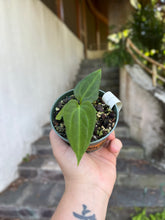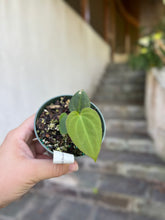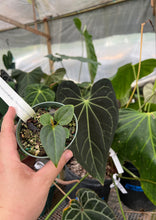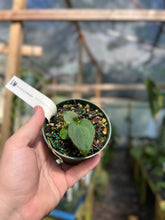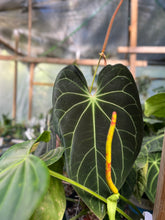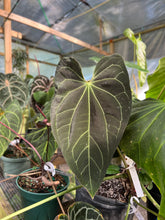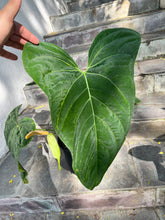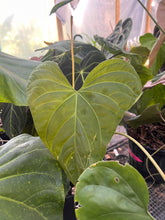
This is a new cross that we’re hoping for highly velvet leaves, and minimal venation. So far they’re developing just the way I hoped.
There are two pictures of each parent plant to better see their traits.
Seed parent: Anthurium Black Beauty (papillilaminum hybrid), a hybrid created by Barry Schwartz. This anthurium showcases dark, velvet leaves with minimal veining, with distinct posterior lobes.
Pollen parent: Green Papillilaminum, a dramatically velvety anthurium with noticeable posterior lobes, and minimal yet vertical venation. I acquired this beast at the IAS show in 2018 with unknown origins.
Each seedling will range from 3-5 leaves.
SOIL:
Anthuriums are typically epiphytic and do well in a substrate with ample aeration- orchid bark, charcoal, coco coir, perlite, and things of that nature assist with aerating your substrate so it is not too dense and holding too much moisture. It is always best to play around with what substrate mixture works best for your environment.
LIGHT:
Anthuriums can survive in lower light conditions, but prefer at least 6 hours of bright, indirect sunlight each day. We grow our seedling under shade cloth, outdoors, for reference. Harsh, direct light may burn the leaves, and very low light could stunt growth and prevent flowering.
WATER:
Anthuriums do well to always have a slight level of dampness, but not constantly soggy.
CONDITIONS:
Anthuriums thrive in a humid environment. If you live in a more naturally humid area like we do, here in Central Florida, outside may be a good spot to keep them. Airflow is essential to prevent water build-up on the leaves, which can lead to fungus.
HISTORY:
Anthuriums are found throughout Central and South America. As of today there are
18 sectional groupings of anthuriums, with each section presenting similar defining traits. We most often offer anthuriums from the cardiolonchium and branchiolonchium sections. Interestingly- these two groups have been successful in crossing and we have two sectional crosses we are eager to grow out.








